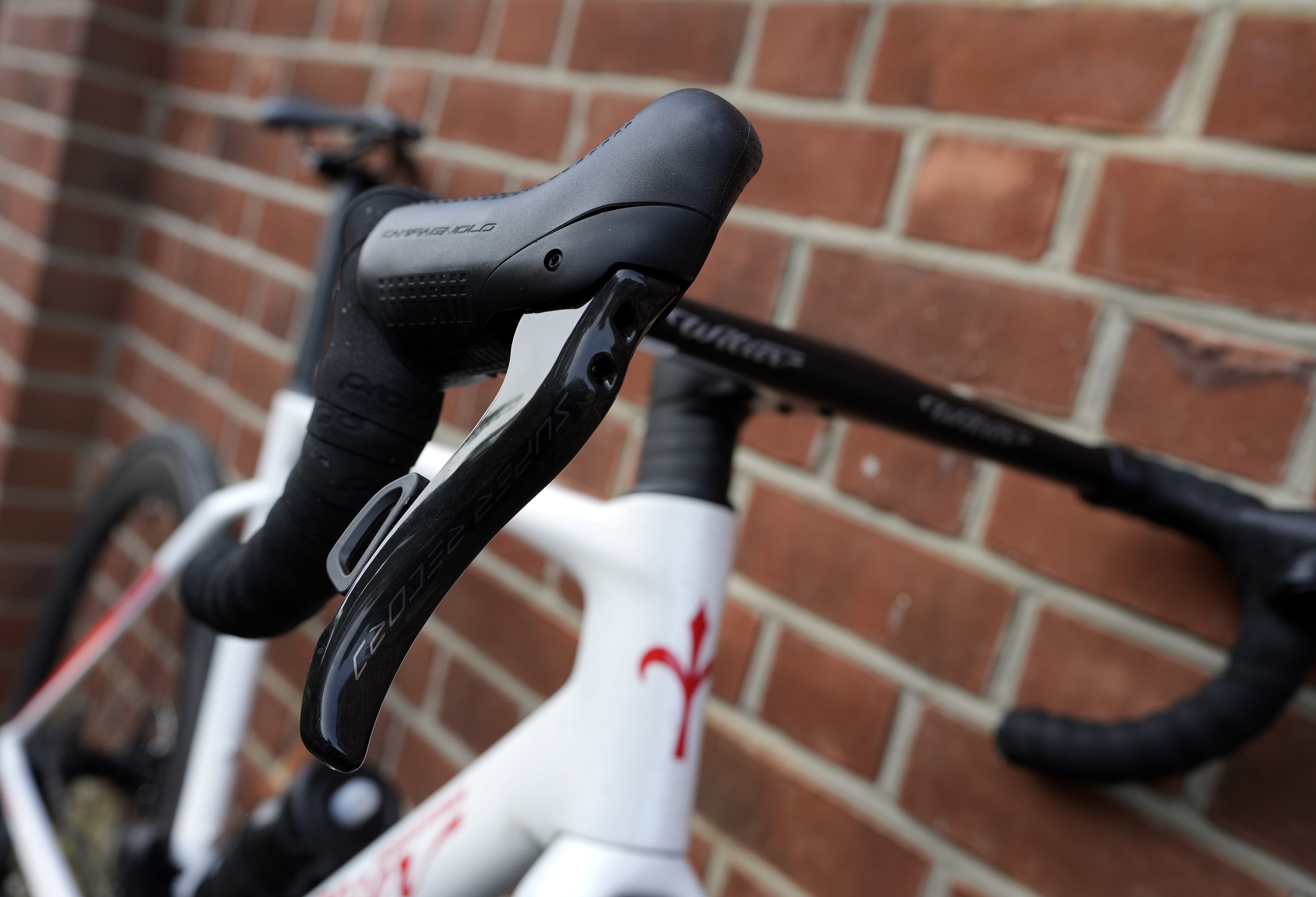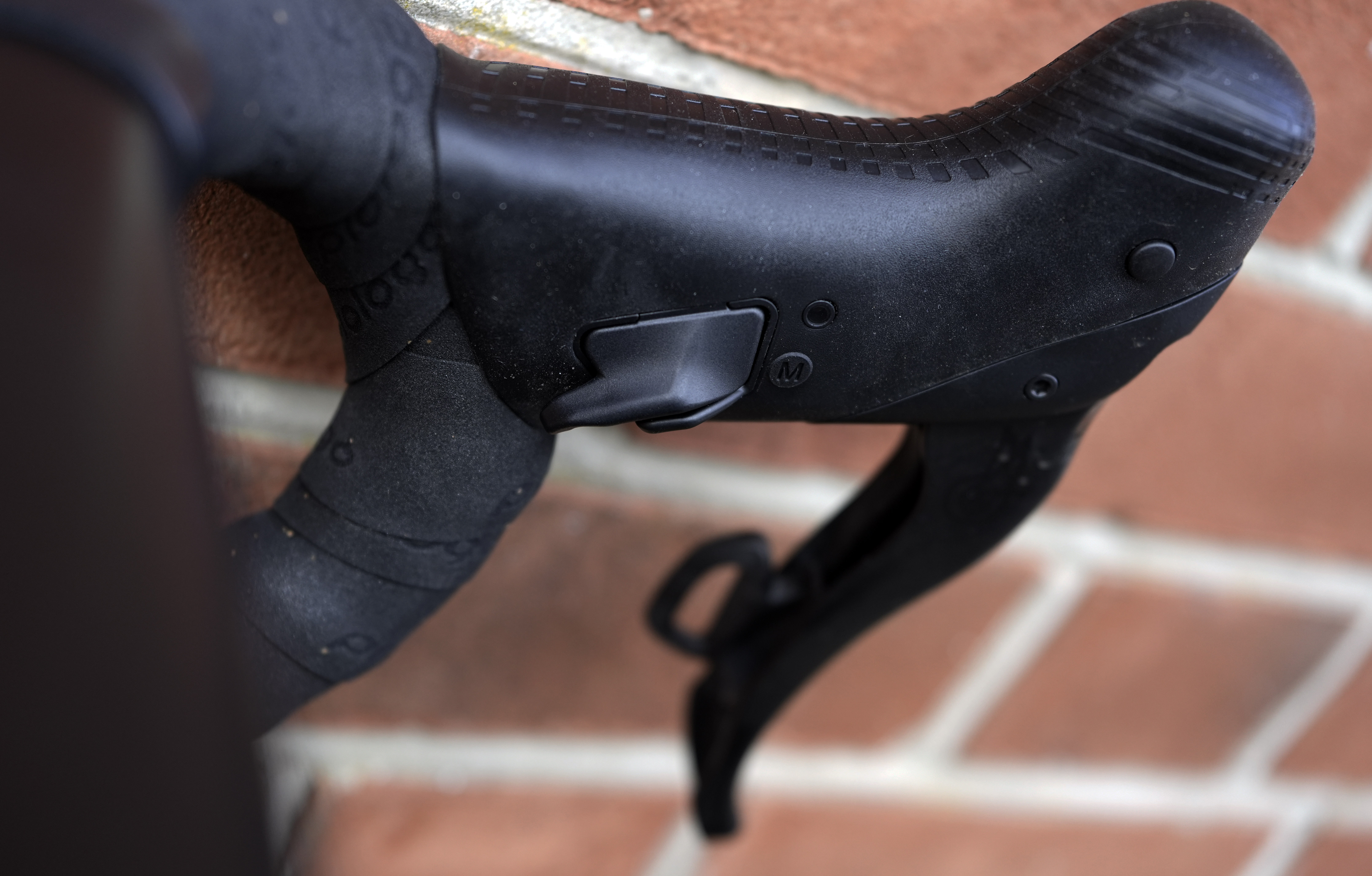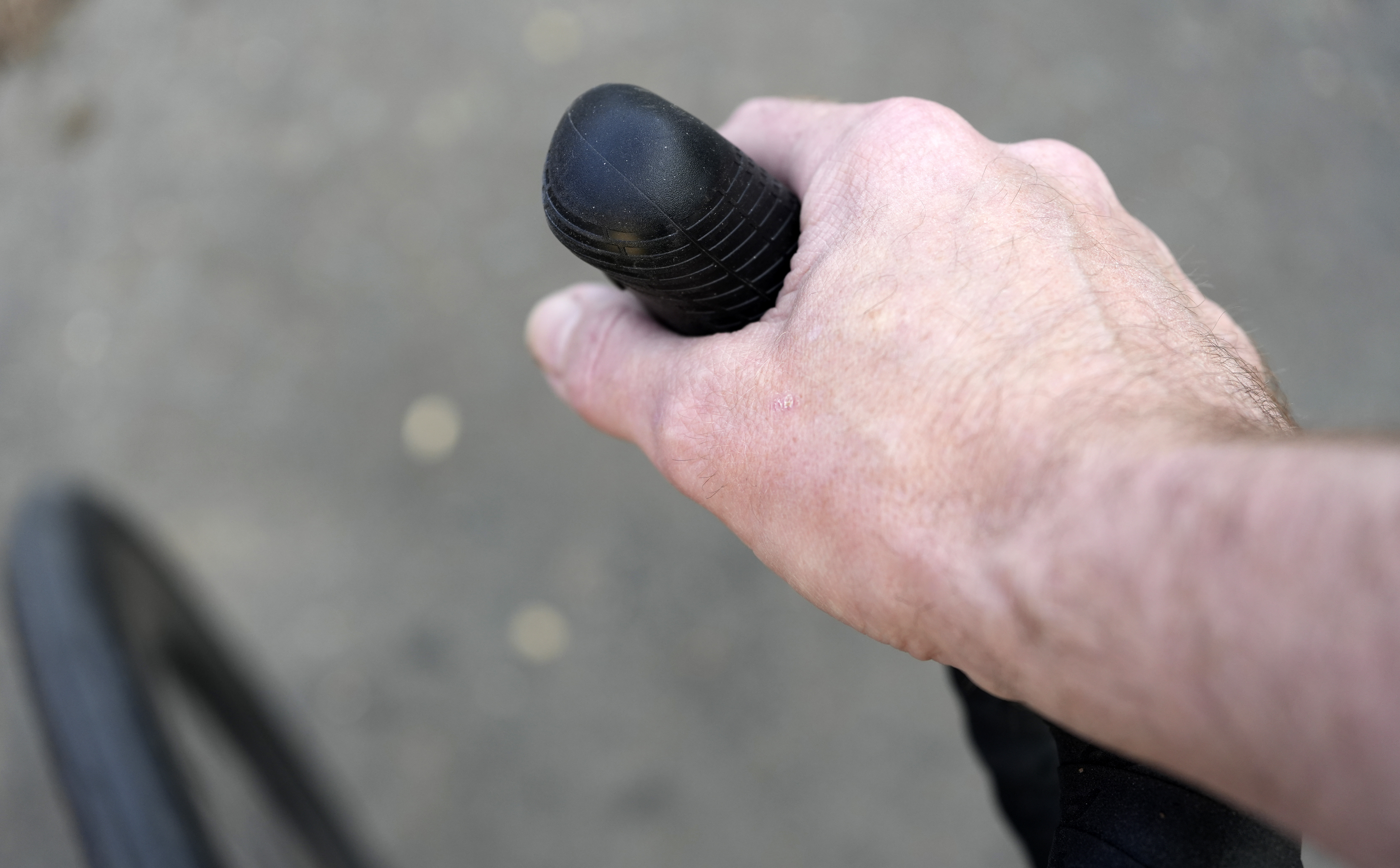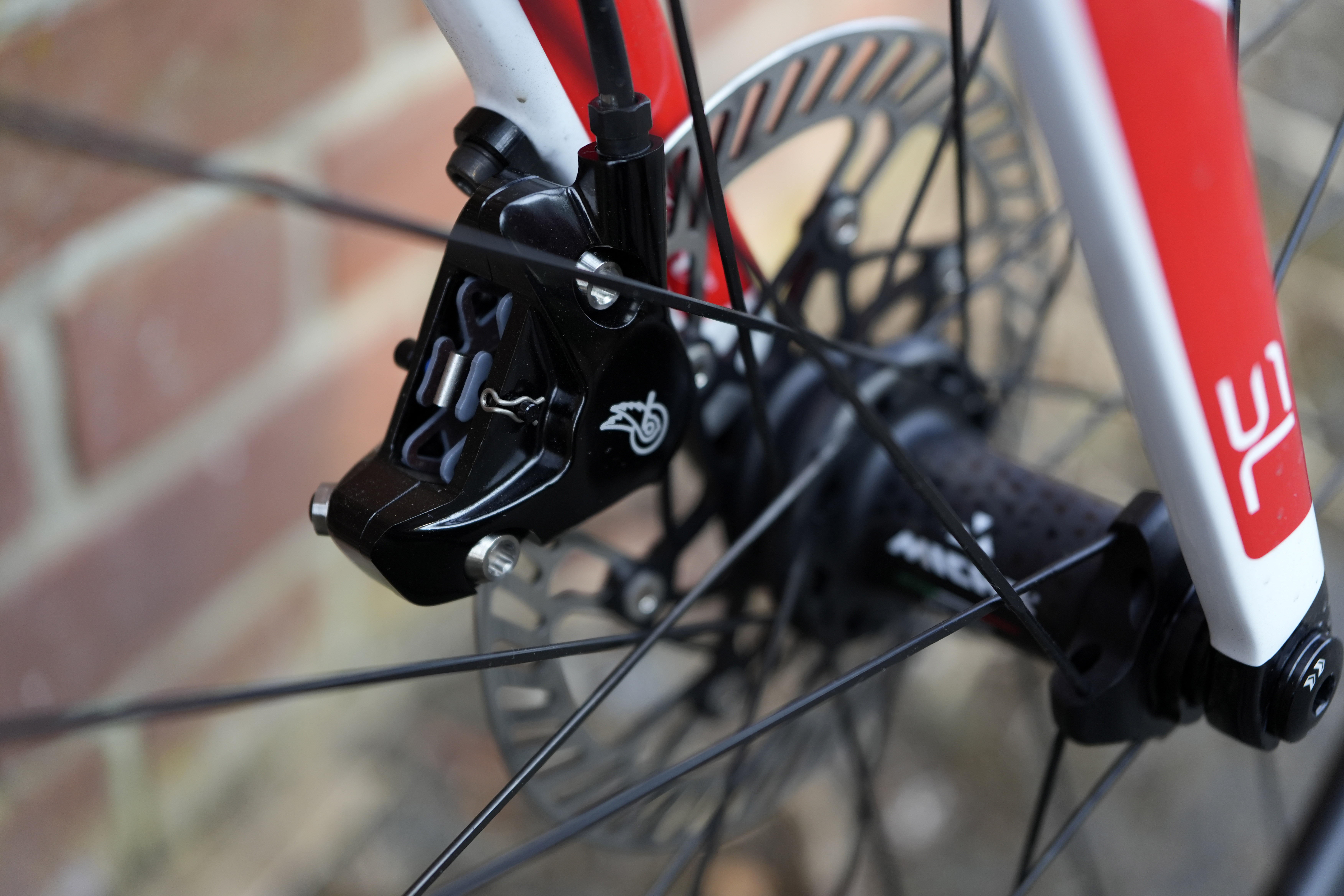I got my hands on Campagnolo’s new Super Record 13-speed wireless groupset just ahead of the launch last week, and I’ve been riding it every day since. In all weathers too. The rolling but largely flat countryside and quiet roads around where I live are the perfect place to examine whether or not anyone needs an extra ratio out back – cadence is key round here – and whilst 13-speed is the headline at the launch of this groupset, I’m just as keen to see if Campagnolo can get itself back in the race for ‘best road groupset’.
At first glance the spec sheet is promising. With the launch of Super Record 13, the Italian brand appears to have gone back to its knitting.
It’s revised the pricing. This new pro-level groupset, whilst not cheap, is now pitched at the same pricing point as both SRAM and Shimano, depending on the spec you go for. The quoted price for a full groupset is now €4,300 / US$4,750 / £3,900, without power.
With a claimed weight of 2445g that would make it the lightest of the big three, and with pricing now competitive at the top tier, the remaining question the new Super Record has to answer, is whether or not it performs, and what is it like to live with. If it can answer those questions emphatically, without the hesitation that came with the last version, Campagnolo could be back in the race. If it can’t, it begs the question, what is Campagnolo for anymore? That for me, would be an operatic tragedy.
Buckle up, this is a long review, but it’s not an exaggeration to say this groupset is of existential importance to Campagnolo’s future, and even if it wasn’t, there’s a ton of components to get through.
Cassette and Chainset
Changes here are minimal, but subjectively, to my eye, this is the best looking chainset on the market.
The revised BB cups are called Quick Tech and I’m told there is no cross compatibility with earlier UT or Protech BB’s. The retainer clip and wavey washer are essentially the other way around, but functionality is largely the same. I suspect Campagnolo has done this to stop any mixing and matching with incorrect chain and rings, now that the chain is narrower. The bearings are still mounted on the axle. While it’s better than chancing the alignment by mounting them in the frame, it’s still a pain for your mechanic.
The latest race content, interviews, features, reviews and expert buying guides, direct to your inbox!
The hirth link remains. Ignore anyone that tells you this isn’t a stiff way to mount a crank. There’s a tube of titanium in there at a wall thickness you wouldn’t find in a roll cage on a Dakar truck. The axle is not going anywhere and you won’t bend it. In operation the cranks do the job they’re supposed to and the drivetrain runs silently and smoothly.
This is the first time I’ve ridden any Super Record product with a 32t cassette out back. That’s news, because even when Frome was killing it up and downhill in the Giro on a Shimano 32t, you still couldn’t buy a series correct 32t cassette for Super Record.
The Wireless launch in 2023 surprised everyone by lurching the other way, by not offering a full-size chainset, not even a mid-compact. Both cassette and crankset options in this new group are more varied and wider ranging than all the other top-tier groups available in the market. That’s a win for Campagnolo, tempered perhaps by the absence of a 160mm crank.
The 13-speed version of the Ultratorque crankset is subtly improved over the last model, with it’s now trademark carbon finish on full display, with the Super Record name subtly applied to the crank arm.
(Image credit: Andy Carr)
The rear derailleur
This is a big mech. While it’s smaller and better proportioned than the last one, the current Dura Ace mech still looks more compact. However, the next version of DA will need to mount batteries in the rear mech. If the XTR launch is anything to go by, Shimano won’t have the sleeker and smaller option for long, and the new Super Record mech does look very special, albeit less elegant than EPS.
If you change under load, the mech responds telepathically, moving the chain up or down the block without hesitation in what feels like half a link, or a blink, and at times, a big crack. If you’re used to sneaking around behind your mates on a stealthy Di2 shift with only a squeak from the motor to give you away, this system is not for you.

Super Record 13’s new rear mech features plenty of carbon, and shifts extremely quickly, with loads of precision. The 14 tooth pulleys create a low resistance path for the chain, and ceramic bearings in the top pulley keep it that way.
(Image credit: Andy Carr)
Speaking of squeaky motors, if you don’t mind an assertive click as the chain finds it’s gear, but hate the rodent-like squeak and groan of the motor in some electric mechs there’s way less of that here. And an immediate shift.
If you change gear the way you should – with mechanical sympathy – the shift can be as quiet as SRAM. I’m not sure it’s ever as quiet shifting as Shimano though, in any circumstances. But, as I’ve alluded to already, I find a Shimano Di2 system too quiet at times, especially in concert with their oft don’t-know-you’ve-pressed-it shifter buttons.
There is no doubt you’ve changed gear in a Super Record system, and that feeling remains. The shift feels like pulling a trigger (pressing the trigger in this case) and the response is just as instantaneous as a gun. There is no discernible moment where the shift button doesn’t feel hardwired to the mech. It’s very quick.
The chain moves through the mech in smooth, spooky silence too. The larger pulleys and ceramic bearings in the top pulley keep it all feeling very luxurious and super efficient. There’s also a fancy black-chrome-esque coating, which may be contributing to the eerily silent running.
The front derailleur
This is simply much better than previous wired versions of EPS with zero chain drag to the next ring, and a significant improvement on the outgoing model. I couldn’t make the chain drag on an up or down shift in any one position on the front or rear cassette. The chain felt under control in every shift. No delay, no snagging, no drag, just a nicely controlled, yet fast, shift, with no fuss.
The other big news on the front mech is that it’s no longer the same size as your Garmin. The battery is fixed on the front, giving more tyre clearance, they say. ‘Leg clearance’ would have been more honest given their last effort. The new design gives plenty of space now, and it’s inline with the other brand’s mechs in terms of profile.

Design of the front mech is now much more in keeping with a groupset at this level, and functionally is superb.
(Image credit: Andy Carr)
Charging and battery life
One thing I haven’t yet mentioned is charging. Batteries can be charged on or off the bike, with a magnetic charge port on the battery itself. The engagement with the charger is via a lightly fitted magnetic connection.
Dura-Ace has a horrendous charging interface that often doesn’t stay in place. No trouble here yet with Campagnolo’s just about magnetic solution, but surely USB-C is due on the next generations of all these items?
Whilst the claimed charging rates are class leading, and it does indeed charge super fast, the rear mech seems to be thirsty on the juice. A longer term review will allow me to assess battery life more fully. I suspect it just prefers a full charge, rather than a blast of electrons here and there, when it’s near one of the few sockets that’s not already charging something else!
The shifters
I can’t talk about shifting without talking about how it’s actuated, once again thank goodness, via a Campy thumbshifter. It is back, reimagined, and very good indeed, operable from a number of useful angles.
One small gripe is that you can unintentionally shift gears when braking and shifting at the same time, such as when approaching a junction. Your hands are loaded up under braking at this point, slowing the bike, with fingers wrapped on the brake lever. There’s a lot of hand for the set up to accommodate in this moment and you can fudge a shift in the wrong direction. Bear in mind I do have size 12 hands. Once you’re aware it’s there and you’ve made provision for it, the thumb shifter never really feels in the way however.

The carbon shifters are premium in both looks and ergonomics, the paddle shift is evident here, with a cutaway area and allows finding it with finger tips both easy, and instinctive.
(Image credit: Andy Carr)
In terms of the function when pressed, both thumb shifter and paddle have a short throw, giving no sense of latency, and at the same time requiring only a light touch. That’s quite a clever mix, especially given the haptic response of the shift button is clear and communicative, and this helps make shifting feel direct, and deliberate. This was my favourite aspect of the system, and the buttons feel great, too. Hold the button for just a while longer and you can dispatch three gears at a time or as many gears as you need without delay. All the buttons on the ergopower lever are configurable in the app, and there’s also a neat ‘one hand’ mode, so you can control both mechs from one lever if needed.

(Image credit: Andy Carr)
The paddle shift lever on the back of the brake lever is a wonder of ergonomics on its own. No matter where your hands are positioned on the hoods, the tip of your ring finger can find the inside edge of the relatively large real estate given to the paddle. The inside edge tells you you’re there, in a way that neither SRAM or Shimano can; the former has a larger but smooth-ish paddle, while the Di2 paddles can be fiddly to locate. Like the thumb shift haptics, you also know you’ve pressed the button, not because of an arduous click or long throw though. It all just feels efficient, and you know you’ve done it.
The mode buttons and new ‘Smart Button’ are all easy enough to operate and fall nicely. I didn’t set up the mode button up, as I didn’t have a head unit mount for the bar on my test bike, but it can theoretically control your head unit, answer a call, or shift tracks on your Spotify. Or any number of other functions. This will be handy for some and brings it into line with competitors.
The hoods and brake levers
Campagnolo knows a lot about ergonomics and the new ergopower lever in the SR13 system is its best work yet. The material used for the hoods feels delicate. It’s tactility could be a sign of weakness, but it’s absolutely not if previous versions (which use the same material) are anything to go by. It feels great, looks better than the other main players, and offers loads of grip.
The new brake lever kicks out considerably, clearing the centre line of the bar, leaving what feels like class-leading clearance for your fingers. The previous versions, and Di2 does trap fingers, way before the brake caliper is entirely on at times. With this design and the short throw on the brake lever, this is way less likely. The levers themselves look very classy, feel good, and they’re adjustable for reach.
The tip of the hood is angled in. Campagnolo says that the design is UCI legal but I could care less about that aspect – the position it affords your hands is brilliant. It leaves your wrist completely neutral, in the same position it would be if hung by your side in the breeze. Fitters rejoice. It is very comfortable indeed.

The ‘tipped in’ hoods are UCI legal and create a neutral position for the wrist, which could reduce fatigue and certainly boosts comfort.
(Image credit: Andy Carr)
The extra gear
Ok, ok. I know, no one was asking for more gears. However, far beyond it being a marketing stunt to sell a few more groupsets and usher in another new standard, there are use cases where it is obviously really beneficial. And to try and placate the cynics, I’ll take a few moments to explain why.
Cadence is often dependent on finding the right gear. Some people don’t worry about cadence and enjoy their riding no less of course, but for those that enjoy road craft, the extra ratio is helpful, especially on a 32.
Fundamentally, the downside of running a 32t cassette is bigger jumps and that problem is better managed here with 13 ratios. In fact, it’s eliminated. For a fast TT style ride over rolling hills, or endurance work on an even smaller cassette where maintaining a consistent power output is essential, there is no downside to having the extra ratio. Especially when the shift feels this fast and addictive.

(Image credit: Andy Carr)
The App – My Campy 3.0
Once set up, you shouldn’t need the app too much. This is good news, because it’s not great as it is. Having experienced initial set up issues with the front mech, I went into the app to look for adjustment, status, and assess set up. I couldn’t. Clicking on the front mech icon serves up the rear mech menu. This is clearly a bug, but this is not forgivable in what is not a pre-launch version of the app.
Functionally, you can access chainline switches, and shift assist (think Syncro shift) and check your battery levels and assign buttons as you wish.
The brakes
The brakes are still brilliant. There wasn’t much needed changing here, but they’ve found some titanium screws to drop a bit of weight (7g) and made some changes to the brake pad, whilst adding a sintered option for better performance in the winter. I rode in wet and dry on the ‘standard’ pads, and Campagnolo’s brake system is still outstanding. Feel is great at the lever, with all the modulation and power that you need.

Titanium hardware in what was already a very competent set of high performance road disc brakes
(Image credit: Andy Carr)
Verdict
Some people will never choose Campagnolo. Shimano offers a conservative, reliable choice that’s hard to ignore, that’s why it’s so dominant.
With this new groupset however, we now have not just an exotic option for your bike transmission, but a rational choice – not without fault – but an alternative that is now about subjective differences not compromise.
With this new groupset, pricing and weight is now competitive. Shifting is not as luxuriant and silent as Di2, but Super Record 13 is wickedly fast – it feels faster than anything else I’ve ridden – and shifts with an aggressive and determined movement, that is addictive and offers something undeniably competitive and high performing, but different.
Campagnolo has remembered that buying and owning Campagnolo parts is not just about performance, but about how they make you feel. Now, far from confused, as some aspects of Campagnolo design has left me feeling in the recent past, this new groupset makes you feel like you made an entirely valid choice to use an alternative transmission that’s different, not worse.
Yes, the app needs work. They can probably fix that with a firmware update. Yes, it is likely fiddlier to set up. But, the hardware and electronics in the main components are once again world class, and look at it.
The laurels of victory have been hung about the neck of Campagnolo components so much in World Tour cycling, that they featured them on their 80th anniversary logo. But just as the Italians created the tradition of awarding laurel wreaths to the victor, they also warned of the dangers of resting on them.
With Super Record 13, it’s clearly thinking straight again. If it can trickle this addictive shifting platform down, without losing the refinement or speed, Campagnolo might finally feel like it’s not just relevant again, but a rational and exciting choice for way more people.
Campagnolo has made a brilliant groupset. Now it just needs to fix the app.

